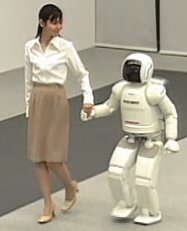Walking Robots - Biped Robots

WALKING ROBOTS THAT “DO THE WALK”
Walking Robots? We’ve seen robots walk, and we’ve certainly seen the robot dance, but when will the more realistic-looking ones, like the singing gynoid, Muse, quit standing around and start using those legs of theirs to start walking?
Despite the name, humanoid robots do not necessarily have to look like humans. They’re simply robots whose overall appearances are based on that of the human body, specifically so they could interact with made-for-human tools or environments.
Humanoid robots therefore do not need to resemble the shape of a human, but are usually composed of either one, a combination or all of the following: a torso with a head, two arms and two legs. Some walking robots--humanoid robots may also have some form of a “face,” complete with a pair of “eyes” and a “mouth.” Androids, on the other hand, are humanoid robots that are built to aesthetically resemble a human, which means they are actually made to look like human beings, some even going as far to utilize rubber that looks and feels like human skin.
Although it is relatively easy to make humanoids walk, a researcher at the Korean Institute of Technology has said that it is quite different for androids intended to look human. The problem lies in the relatively lean shape of the android’s legs: To make a robot walk, its legs usually have to be big enough to support the mechanism used to power its movements.
So far the only android able to walk without having unnaturally thick legs is Japan’s HRP-4C, who can also sing and perform simple dance steps. Her developers say that this “cybernetic human” isn't ready to help with daily chores or work side by side with humans yet but she sure can entertain crowds with her numbers.
HRP-4C, who was developed by the National Institute of Advanced Industrial Science and Technology (AIST), has 30 motors in its body that allow it to walk and move its arms, as well as eight motors on its face to create human expressions. Aside from her, however, most walking, dancing, climbing, and game- playing robots are humanoids, who despite their unrealistic human forms, are designed to move as realistically human as possible. This is a great walking robot.
There’s Nao, an autonomous, programmable and bipedal humanoid robot developed by the French company Aldebaran Robotics. In 2010, Nao made headlines when he performed a synchronized dance routine at the Shanghai Expo. Vietnam has TOPIO or “TOSY Ping Pong Playing Robot,” a bipedal humanoid robot designed to play table tennis against human beings. Of course, there is Honda’s ASIMO, or "Advanced Step in Innovative Mobility," a humanoid robot resembling a small astronaut who can walk or run at speeds of up to 6 km/h (3.7 mph).
There was QRIO or "Quest for cuRIOsity," from Sony, who was supposed to be a bipedal, humanoid entertainment robot developed and marketed for commercial release but was never sold. Korea has HUBO or “HUmanoid roBOt," a walking humanoid robot with a realistic human head mounted on a cartoonish frame, developed by the Korea Advanced Institute of Science and Technology (KAIST). Their most recognizable model to date is Albert Hubo, which sports Albert Einstein’s head.
This author is also working on a robot that walks. Her name is Robot Betty9. Currently she "Roomba surfs" but does not walk.
Until now, researchers are working doubly hard to create the perfect walking robot. Even the most famous current example, the Honda Asimo, who probably moves the smoothest, is criticized for some flaws: having large, flat feet and consuming too much energy. Cornell University, the Massachusetts Institute of Technology (MIT) and Holland's Delft University of Technology have come together to build robots that could more closely mimic the human gait and match human efficiency.
Using simple mechanical walking toys from the 1800’s as inspiration, they’ve developed Toddler, named because the robot can teach itself to walk in less than 20 minutes, or about 600 steps. The robot is reportedly one of the first walking robots to use a learning program, and is the first to learn to walk without any prior information built into the controller. Another professor, this time from Oregon State University, Jonathan Hurst, is using a different approach: he hopes to instill in robots the movement capabilities found in animals and humans.
Hurst says that we see robots which work very well in controlled environments, meaning “walking on very flat ground.” Their movements look fluid, but once it hits any disturbances or any bump in the ground, their movement is disturbed. He says these robots are completely passive walkers: robots that aren’t really robots, just mechanical pieces who don’t have any electronics on them. “I’m trying to really understand how animals work and how we can optimize machines.
If we can really understand how animals move, that means we can replicate it in a robot,” Hurst explains. “If we could demonstrate in a robot a human- or animal-like locomotion, that means we can build exoskeletons and prosthetic limbs for humans. We want robots getting around in human environments. We’re going to want robots in our homes. We’re going to want robots in hospitals, taking care of people. We’re also going to want robots in construction sites. We’re going to want robots in military situations to get around rough urban terrain, up and down stairs, through doors.”
Point taken. Although fascinating for sure, there’s really not a lot of use for a robot who can sway her hips back and forth while singing in perfect pitch. Besides, we’ve got too many humans all too ready and willing to do that for us.